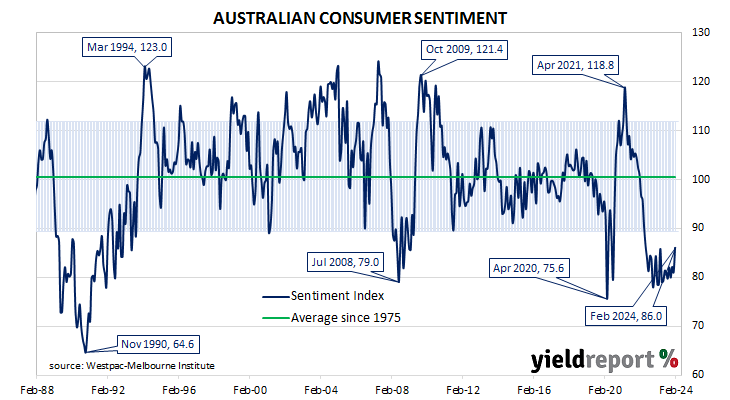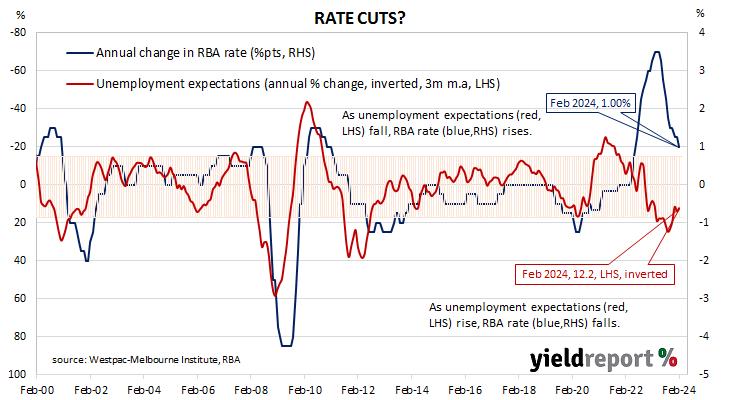Summary: Westpac-Melbourne Institute consumer sentiment index up in February; moderating inflation, interest-rate expectations main factors behind lift; ACGB yields increase modestly; rate-cut expectations soften; responses over survey week show sharp turnaround post-RBA policy decision; all five sub-indices higher; fewer respondents expecting higher jobless rate.
After a lengthy divergence between measures of consumer sentiment and business confidence in Australia which began in 2014, confidence readings of the two sectors converged again in mid-July 2018. Both measures then deteriorated gradually in trend terms, with consumer confidence leading the way. Household sentiment fell off a cliff in April 2020 but, after a few months of to-ing and fro-ing, it then staged a full recovery. However, consumer sentiment has deteriorated significantly over the past two years, while business sentiment has been more robust.
According to the latest Westpac-Melbourne Institute survey conducted in the second week of February, household sentiment has improved but remains at quite a pessimistic level. Their Consumer Sentiment Index rose from January’s reading of 81.0 to 86.0, a reading which is still below the “normal” range and significantly lower than the long-term average reading of just over 101.
“While sentiment is still firmly pessimistic there finally looks to be some light at the end of the tunnel for Australian consumers,” said Westpac senior economist Matthew Hassan. “Moderating inflation and shifting expectations for interest rates appear to be the main factors behind the lift, with some additional support coming from the prospect of broader income tax cuts later in the year.”
Any reading of the Consumer Sentiment Index below 100 indicates the number of consumers who are pessimistic is greater than the number of consumers who are optimistic.
The figures came out on the same day as the latest NAB Business survey and Commonwealth Government bond yields increased modestly on the day. By the close of business, 3-year and 10-year ACGB yields had each added 1bp to 3.75% and 4.19$% respectively while the 20-year yield finished 2bps higher at 4.49%.
In the cash futures market, expectations regarding rate cuts later this year softened. At the end of the day, contracts implied the cash rate would remain close to the current rate for the next few months and average 4.305% through March, 4.29% in April and 4.255% in May. However, August contracts implied a 4.145% average cash rate while November contracts implied 3.99%, 34bps less than the current rate.
“Responses over the survey week show a sharp turnaround midweek, following the announcement of the RBA Board’s February policy decision,” added Hassan. “Those surveyed prior to the decision recorded a sentiment index read of 94.1. Those surveyed post the decision recorded a sentiment read of just 80.”
All five sub-indices registered higher readings, with the “Time to buy a major household item” sub-index posting the largest monthly percentage gain.
The Unemployment Expectations index, formerly a useful guide to RBA rate changes, fell from 130.7 to 126.9. Lower readings result from fewer respondents expecting a higher unemployment rate in the year ahead.



